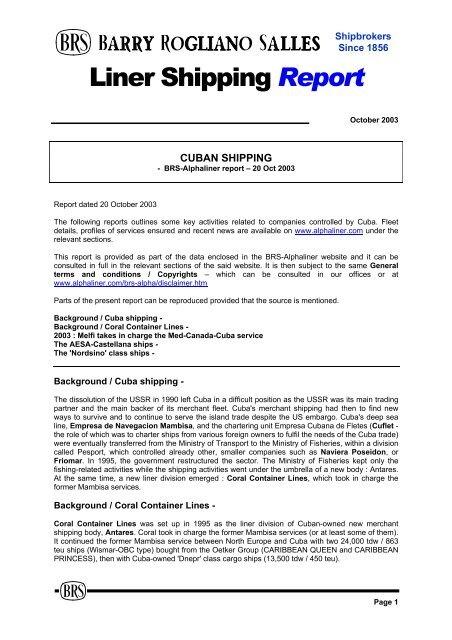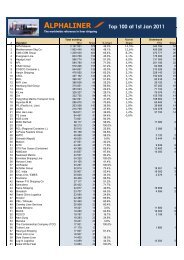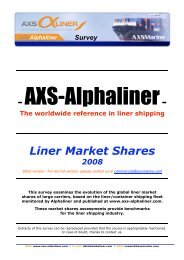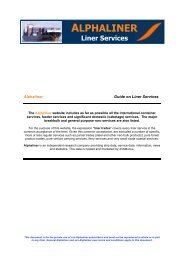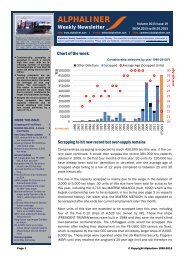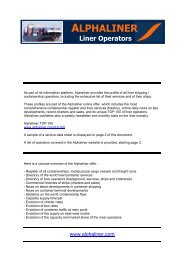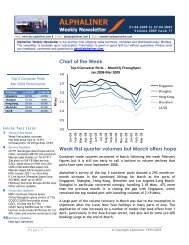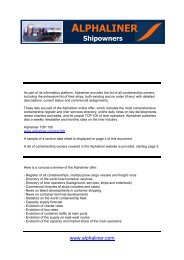Liner Shipping Report - Alphaliner
Liner Shipping Report - Alphaliner
Liner Shipping Report - Alphaliner
You also want an ePaper? Increase the reach of your titles
YUMPU automatically turns print PDFs into web optimized ePapers that Google loves.
Shipbrokers<br />
Since 1856<br />
<strong>Liner</strong> <strong>Shipping</strong> <strong>Report</strong><br />
October 2003<br />
CUBAN SHIPPING<br />
- BRS-<strong>Alphaliner</strong> report – 20 Oct 2003<br />
<strong>Report</strong> dated 20 October 2003<br />
The following reports outlines some key activities related to companies controlled by Cuba. Fleet<br />
details, profiles of services ensured and recent news are available on www.alphaliner.com under the<br />
relevant sections.<br />
This report is provided as part of the data enclosed in the BRS-<strong>Alphaliner</strong> website and it can be<br />
consulted in full in the relevant sections of the said website. It is then subject to the same General<br />
terms and conditions / Copyrights – which can be consulted in our offices or at<br />
www.alphaliner.com/brs-alpha/disclaimer.htm<br />
Parts of the present report can be reproduced provided that the source is mentioned.<br />
Background / Cuba shipping -<br />
Background / Coral Container Lines -<br />
2003 : Melfi takes in charge the Med-Canada-Cuba service<br />
The AESA-Castellana ships -<br />
The 'Nordsino' class ships -<br />
Background / Cuba shipping -<br />
The dissolution of the USSR in 1990 left Cuba in a difficult position as the USSR was its main trading<br />
partner and the main backer of its merchant fleet. Cuba's merchant shipping had then to find new<br />
ways to survive and to continue to serve the island trade despite the US embargo. Cuba's deep sea<br />
line, Empresa de Navegacion Mambisa, and the chartering unit Empresa Cubana de Fletes (Cuflet -<br />
the role of which was to charter ships from various foreign owners to fulfil the needs of the Cuba trade)<br />
were eventually transferred from the Ministry of Transport to the Ministry of Fisheries, within a division<br />
called Pesport, which controlled already other, smaller companies such as Naviera Poseidon, or<br />
Friomar. In 1995, the government restructured the sector. The Ministry of Fisheries kept only the<br />
fishing-related activities while the shipping activities went under the umbrella of a new body : Antares.<br />
At the same time, a new liner division emerged : Coral Container Lines, which took in charge the<br />
former Mambisa services.<br />
Background / Coral Container Lines -<br />
Coral Container Lines was set up in 1995 as the liner division of Cuban-owned new merchant<br />
shipping body, Antares. Coral took in charge the former Mambisa services (or at least some of them).<br />
It continued the former Mambisa service between North Europe and Cuba with two 24,000 tdw / 863<br />
teu ships (Wismar-OBC type) bought from the Oetker Group (CARIBBEAN QUEEN and CARIBBEAN<br />
PRINCESS), then with Cuba-owned 'Dnepr' class cargo ships (13,500 tdw / 450 teu).<br />
Page 1
<strong>Liner</strong> <strong>Shipping</strong> <strong>Report</strong><br />
Coral Container Line - October 2003<br />
The line was however downgraded in 1998 and 1999 (to end with spot sailings, in co-operation with<br />
Friomar), and was actually taken in charge by a company controlled by Cuba based in the<br />
Netherlands, Melbridge Container Line (itself founded in 1994).<br />
Melbridge C.L. uses to operate two or three chartered ships of around 1,000 teu on this service, which<br />
links Rotterdam, Le Havre and Bilbao to Canada (St John) and Cuba (Havana) with further oncarriage<br />
to Mexico.<br />
As for Coral, it set up domestic services allowing to link Cuba to neighbouring hubs, partly in cooperation<br />
with foreign partners (such as CGM which was involved as soon as 1995). Coral launched<br />
soon a service linking Italy, Spain and Cuba (Spain is an historic partner of Cuba), and calling also at<br />
the Caribbean hub of Kingston in order to attract third party business (6105).<br />
The service was ensured with the three 'Nordsino' class ships (see related item). As the service grew<br />
up in size, Coral started to charter 900 to 1,100 teu units to replace them, and also to increase the<br />
frequency. This chartering policy started in early 2000, with ships chartered for six months periods.<br />
Thus in 2001, the service was ensured with four chartered ships averaging 1,100 teu (LAURITA<br />
RICKMERS, JADE TRADER, ESTECLIPPER, ELBSTRÖM). Coral even attracted Hapag-Lloyd as a<br />
slot buyer (HL used the service as a Med-Caribbean service, transhipping cargo at its Kingston hub<br />
but was not involved in the Cuba trade).<br />
In 2002, the service was progressively downgraded, probably because of intensified pressure on the<br />
Med-Caribbean trade (via Kingston), and on the Med-Cuba trade itself, especially with the rise of a<br />
rival services launched by Costa Container Lines (6185 / 6186 / 6266), as Cuba started slowly to<br />
open its foreign trade. Another blow was that Hapag-Lloyd did not renew its slot buying agreement.<br />
The chartered ships were progressively returned to their owners as their charter expired, the last one,<br />
the 1,107 teu ELBSTRÖM having been returned in September 2002. Coral went on however, with inhouse<br />
tonnage, such as the 896 teu SEAGREEN and SUNGREEN or even the 844 teu RITA, diverted<br />
from the Coral Cuba feeder service. In August and September 2002, it also chartered 500 teu ships on<br />
a short term basis (round voyages) in order to fulfil its commitments (such as the 417 teu ATLANTIK<br />
and the 574 teu CLAUDIA A.). In the end, Coral bought slots from third pary operators, including the<br />
Costa C.L. service.<br />
Coral had also set up a three ship loop within the Caribbeans, acting as a feeder loop hubbing at<br />
Kingston (run initially with 400 teu mp tonnage -including Dnepr ships-, replaced in September 2000<br />
by the three 844 teu 'Nordsino' type ships since September 2000 - transferred from the Med-Cuba<br />
line), and a weekly Jamaica (Kingston)-Havana shuttle run with the 320 teu NUEVITAS. These feeder<br />
services have been closed in September 2002 and the four ships have been returned to their owners.<br />
2003 : Melfi takes in charge the Med-Canada-Cuba service -<br />
Melfi Marine Corporation is a Cuban-owned company registered in Panama, founded in 1981. It is<br />
currently 'owned' by the CIMEX Enterprise Group (CIMEX = Comercio Interior - Mercado Exterior), a<br />
private commercial organization belonging to the Cuban government. Besides shipping, CIMEX is<br />
active in real estate, legal matters, wholesale and retail services.<br />
Melfi Marine Corporation operates under the brand name 'Melfi Lines'. It has been operating a service<br />
between Canada (Halifax) and Cuba (6206), using multipurpose tonnage. Nickel byproducts are<br />
believed to form the main cargo on this service. It operates also a regional service linking Havana to<br />
Mexico, Panama and the NCSA (6876), acting also as a relay service used by Melbridge Container<br />
Line, a Netherlands-based company controlled by Cuban interests.<br />
Page 2
<strong>Liner</strong> <strong>Shipping</strong> <strong>Report</strong><br />
Coral Container Line - October 2003<br />
In September 2003, Melfi Lines launched a service linking the Med to Canada and Cuba (6188), which<br />
took the cargoes formerly carried by the Med-Cuba service operated by Coral Container Lines until<br />
September 2002. When this latter service was closed, the freight carried was shifted to the relevant<br />
service of Italian operator Costa Container Lines (6186).<br />
Melfi has chartered three ships to ensure it : the 749 teu CONTAINERSHIPS IV (alias SPICA), the<br />
1,102 teu ALASSA and the 878 teu SAYINUR YARDIMCI. The CONTAINERSHIPS IV and ALASSA,<br />
renamed MELFI ITALIA and MELFI HABANA.<br />
ANNEX on key ships<br />
The AESA-Castellana ships -<br />
In the early 1980s, it was decided to modernise the fleet of state-owned Empresa de Navegacion<br />
Mambisa (then including SD 14s and Dnepr class ships). An arrangement was found to have new<br />
cargo ships ordered in Spain (Astilleros Españoles - AESA). Although details of the financing remain<br />
unknown, the ships were actually ordered by Castellana, a Spanish firm linked to AESA, which has<br />
sublet the ships for a long period to Cuba under a bare-boat charter agreement. Thus, in 1985-86,<br />
Mambisa received from AESA a series of eight multipurpose cargo ships of 16,200 tdw and 519 teu,<br />
starting with the BAHIA DE MANZANILLO (in order to obtain the full list, enter the SHIPS page / click<br />
Class-design : 'Aesa-Castellana'). However, difficulties linked to the loss of the USSR backing did not<br />
allow the Cuba government to fulfil its obligations with AESA-Castellana, and with other creditors as<br />
well, and the ships were recovered by their Spanish owners and put up for sale. All eight ships were<br />
sold in 1996, seven of them having been bought by Bangkok-based Thoresen & Co (and were given<br />
THOR style names) while the remaining one went to South Korea-based Hansung <strong>Shipping</strong>.<br />
The 'Nordsino' class ships -<br />
As the container invaded the Cuba trade in the 1980s, it became urgent to cover the country<br />
containerised foreign trade with adequate tonnage. The government bought three 844 teu ships from<br />
China, delivered in 1988-89 by the Shanghai Shipyard. These ships were based on a German design,<br />
known as the 'Nordsino' type (of which five were built for German owners in the early 1980s). They<br />
were the first Cuban cellular ships and were delivered to Mambisa as the SIERRA MAESTRA,<br />
ERNESTO CHE GUEVARA and CAMILO CIENFUEGOS and soon renamed (1990) in GIORITA,<br />
ENERGY and ALBONICA. In turn the two latter ones became GROSSERMAN and GUTTERMAN in<br />
1995.<br />
In 2000, the three ships were sold to Greek owner Lagoa <strong>Shipping</strong> Corp., and the their management<br />
was entitled to London-based Millemium <strong>Shipping</strong>. They were renamed AMALIA, ANA and RITA. They<br />
stayed however operated by Coral under a charter back arrangement, which came to an end in<br />
September 2002. As for the buyer, Lagoa <strong>Shipping</strong>, it was already involved with Coral C.L. as the<br />
owners of the Coral-chartered 320 teu NUEVITAS, a former ship delivered in the name of the Baltic<br />
Shg Co and sold by its Russian successors to Lagoa in 1997, and also as buyers -in 1997- of the two<br />
24,000 tdw / 863 teu conbulkers CARIBBEAN QUEEN and CARIBBEAN PRINCESS, earlier reported<br />
as bought by Cuba from the Oetker Group.<br />
Page 3


